Just like food, stories from around the world have a special flavor. They introduce us to culture, celebrations, festivities, and some wisdom. They introduce us to humor, fun, and most of all to the human experience that unites us. We present stories for all ages from a spectrum of experiences mirrored by fellow beings. Join the International Reading Association’s Children’s Literature and Reading Special Interest Group (CL/R SIG) for a week of globetrotting as we gather books and stories from around the world.
Grade K-2 readers
Bebe, Katy. (2014). Brother Hugo and the Bear. Illus. by S. D. Schindler. Grand Rapids, MI: Eerdmans Books for Young Readers.
 Set in Medieval times, the story recounts the adventures of Brother Hugo, who lives in a monastery and has just lost a library book—to a bear. The precious book with the letters of St. Augustine has to be replaced. The abbot assigns Brother Hugo the task of going to another monastery where there is another copy. When he has the book in hand, Hugo starts for home again, just to be chased by the bear again! Brother Hugo speeds through the fields, orchards, gardens, and buildings. Back home, Brother Hugo thinks it would be impossible to copy the entire book all by himself, but his fellow brothers help him to make the parchment, ink, and light. Every day, Brother Hugo sits for long hours copying the book—line by line, page by page. Hugo knows the bear will chase him again when he returns the book, but his brothers in the Abbey have a trick up their sleeve. Who will win, the bear or brother Hugo? This is an excellent book to discuss history, humor, and talk about how people live different lives even today.
Set in Medieval times, the story recounts the adventures of Brother Hugo, who lives in a monastery and has just lost a library book—to a bear. The precious book with the letters of St. Augustine has to be replaced. The abbot assigns Brother Hugo the task of going to another monastery where there is another copy. When he has the book in hand, Hugo starts for home again, just to be chased by the bear again! Brother Hugo speeds through the fields, orchards, gardens, and buildings. Back home, Brother Hugo thinks it would be impossible to copy the entire book all by himself, but his fellow brothers help him to make the parchment, ink, and light. Every day, Brother Hugo sits for long hours copying the book—line by line, page by page. Hugo knows the bear will chase him again when he returns the book, but his brothers in the Abbey have a trick up their sleeve. Who will win, the bear or brother Hugo? This is an excellent book to discuss history, humor, and talk about how people live different lives even today.
—Rani Iyer, Washington State University Pullman
Dumont, Jean-Francois. (2014). The Geese March in Step. Grand Rapids, MI: Eerdmans Books for Young Readers.
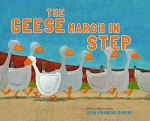
This charming picture book from French author Jean-Francois reassures young readers about the importance of being oneself. Led by fellow goose Igor, the geese on the farm march down to the pond every day in great precision. One-two, one-two, one-two, they march in perfect time. Nobody remembers why they do this anymore, not even the geese, but they do it anyway. One day, Igor hear the rhythm of the perfect march ruined by
tap…
tap. Igor stops the marching geese and spots Zita, a goose who cannot march in synch with the parade. Zita has to go. But Zita’s sniffles and tears make a great rhythm. Woodpecker picks up the tune and joins Zita. The rooster, donkey, cow, and sheep all follow Zita, adding to the tune. When Zita returns to the pond, the geese are stunned to see the unusual parade behind her. Everyone stops following Igor, waiting instead for Zita to lead the march to the pond. This heartwarming tale is perfect for read-aloud and for young readers to join the marching song, each student or group making their own tunes. Teachers can build many class activities around this book.
—Rani Iyer, Washington State University Pullman
Lo, Rich. (2014). Father’s Chinese Opera. New York, NY: Sky Pony Press.

As the son of a bandleader and composer of the Chinese Opera, a little boy usually goes to the theater with his father for the opera rehearsals and performances. Mesmerized by various well-executed acrobatic moves, such as martial arts feats, flips, and somersaults, the boy asks a master of acrobatics, Gai Chui, to teach him all the moves and promises to be a hard-working student. Gai Chui consents, and the boy’s training starts. The more the boy practices, the more he feels he could be part of the opera. As the boy proposes the idea of performing on the stage to Gai Chui, he receives nothing but ridicule from his teacher and other performers. Feeling hurt by the mocking at first, the boy finally realizes it takes many efforts and repeated practice for an actor to perform onstage. Based on his personal experience, Rich Lo has told this story to embody an old Chinese proverb that is still used frequently today: One minute’s performance on the stage takes 10 years of practicing off the stage. The colorful watercolor illustrations correspond to the multiple hues in costumes and make-up Chinese Opera actors wear. This is an introductory book for everyone to get to know a Chinese work of art.
—Ying-Hsuan Lee, Washington State University Pullman
Senior, Olive. (2014). Anna Carries Water. Illus. by Laura James. Vancouver, Canada: Tradewind Books.
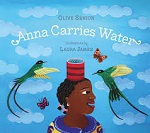
The simple, yet heartwarming story is set in Caribbean islands. Anna’s family gets water from the nearby river for drinking and cooking. Children walk through Farmer Johnson’s fields, amidst the cows, to fetch the water. Anna is scared of the cows and she cannot balance the coffee can on her head, spilling water and drenching herself. Doris, her sister, helps her dry up and assures her that one day she will carry the pot on her head. Like any other day, Anna fills her can, but is slow to follow her siblings. When she crosses the farmer’s field, she is alone. The cows look at her and Anna runs all the way home. Her delighted family celebrates Anna’s trip without spilling a drop of water. This is a good book to introduce how children live across the world. It is also a great book to start the conversation about how children have overcome their own limitations successfully.
—Rani Iyer, Washington State University Pullman
Grades 3-5
Jiang, Emily. (2014). Summoning the Phoenix: Poems and Prose about Chinese Musical Instruments. Illus. by April Chu. New York, NY: Shen’s Books.

Composed of several poems and prose, this book introduces readers to Chinese musical instruments and Chinese orchestras. As readers turn the page, they read how each child learns and practices to play a Chinese musical instrument as well as rehearses for an upcoming concert. Being a part of a Chinese orchestra, these children relate their enjoyment and frustration with mastering their instrument. On each double-spread page, there is a brief explanation of an instrument and within the explanation is a comparison to Western instruments (e.g. Erhu to the violin and Dizi to the bamboo flute) to help readers imagine the sound of each instrument. The illustrations provide not only more details about how Chinese instruments look, but also some objects prominent in Chinese culture, such as Chinese knots, lotuses, cranes, and cheongsams. Be sure to read the author’s note on the last page to learn more about Chinese music!
—Ying-Hsuan Lee, Washington State University Pullman
Raschka, Chris. (2014). The Cosmobiography of Sun Ra: The Sound of Joy is Enlightening. Somerville, MA: Candlewick Press.
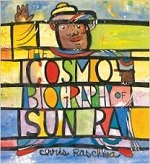
Sun Ra always believes he is from Saturn. Since his landing on Earth in 1910s, his curiosity has driven him to explore everything, including nature, human beings, philosophy, food, etc. But music is his favorite. As a talented musician, Sun Ra masters the piano at the age of 11 and becomes a professional pianist before leaving high school. Besides his love for music, Sun Ra is also a keen observer who is aware of what is happening around him and in the world at large. He notices people separate one from another due to skin colors, and people fight with each other in great wars. To cope with such harshness in reality, Sun Ra decides to use music to bring people together. As a pioneer of using electric devices, Sun Ra forms a band, tours and performs in different cities and countries, meeting many talented musicians along the way. Until the day he returns to Saturn, Sun Ra still believes music can hold everyone together! Chris Raschka tells a story of an extraordinary African-American musician with his distinguished watercolor illustrations. The use of colors, strokes, and lines add a feel of flowing music. This is a biography to introducing readers to an outstanding musician who devoted his life to music and peace.
—Ying-Hsuan Lee, Washington State University Pullman
Grades 6-8
Jones, Kari. (2014). So Much for Democracy. Custer, WA: Orca Book Publishers.
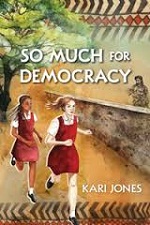
Asteroid, or Astrid as she likes to be called, is in Ghana. Her family moved from Canada after her father took a job to monitor elections. Her brother Grodo and her little sister, Piper, only make her life complicated. Everything is different in Ghana. The school, the people, food, and scenery are very different from what she is used to in Canada. In Ghana, children are not allowed to go play with others, school is the only option to see friends. Astrid makes friends fast, but she struggles with the strict nun she has for a teacher, wearing a school uniform and getting grounded. Life becomes tolerable when she meets Thema. As their friendship grows, the trouble in Ghana also grows. As soldiers march and interrupt every aspect of her life, Astrid is forced to cope with snakes, spiders, sand, and soldiers in her life. Or does she? The author clearly presents how tensions rise between Astrid’s mother, worried and scared, and the kids who go out and explore the world and making friends. Scenes filled with tension, including one in which a soldier takes away their mother’s purse, make the story gripping to middle grade readers. This is a great book for understanding another culture and the struggles of a nation.
—Rani Iyer, Washington State University Pullman
Preus, Margi. (2014). West of the moon. New York, NY: Abrams/Amulet Books.
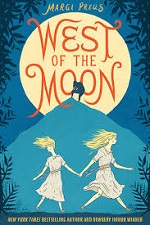
After being sold to a mean goat herder by her aunt and uncle, young Astri lives a life as a servant and a farm laborer. Her imagination and stories are her temporary shelters from harsh reality. Not until the day Astri finds a reticent girl who spins yarn everyday does she makes up her mind to escape with the Spinning Girl. Fetching her younger sister, Greta, Astri becomes the leader of three girls for a risky journey from Norway to America. Told from Astri’s point of view, this fictional narrative blends magic, myth, and Norwegian folktales. Readers need to follow Astri’s thoughts to understand how the three girls use the power of spells, books, and stories to support them through predicaments on their way to a new life. This is a book that shows the readers how female characters have exercised their agency and strength in search of a better future. Careful readers may also recognize the correspondences between Astri’s experience and many folktales.
—Ying-Hsuan Lee, Washington State University Pullman
Grades 9-12
Bahadur, Gaiutra. (2014). Coolie Woman: The Odyssey of Indenture. Chicago, IL: The University of Chicago Press.
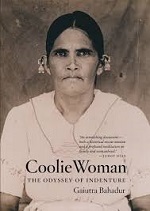
In a personal journey, Gaiutra Bahadur brings to light the horrific truths of colonial lifestyle and sufferings of her great-grandmother, Sujaria. The story begins in 1903 when Sujaria sailed from the shores of India to work in the sugar plantations of the Caribbean. Centuries later, Bahadur travels three continents to piece her life together. Sujaria probably did not know she was replacing the newly emancipated slaves and was entering a new country, alone and pregnant when she entered British Guyana as an indentured labor—a “Coolie.” Intertwined in the shadow of Sujaria are fates and stories of about a quarter of a million coolies who faced the life of exploitation and dismal living conditions. Returning to India meant returning to difficult conditions and realities the women had run away from. Bahadur wonders why Sujaria might have put up with all the struggles and never returned home, “…
One of her granddaughters remembers that she used to cry bitterly to see it again. But she never did. Perhaps she knew that India was best kept in the past—that it would stay sweet as long as she shed tears for it, and desired it, but never actually held and beheld it. Perhaps she was wise enough to know the subtle tricks that nostalgia plays. Or, perhaps she had the good sense to realize that she had acquired things outside India that would irrevocably estrange her from it—Guiana-born children, a husband not of her caste. Neither fabulously rich nor crushingly poor, she belonged to the vast majority who stayed in the West Indies to build a future, in her case a humble empire of cows along the Canje Creek.” Meticulously researched and well-written, the book is a fascinating read for anyone interested in women, colonial history, slavery, and the brave stories women script in silence. The website dedicated for the book has plenty of other resources:
http://cooliewoman.com/. Read about Bahadur’s interview in
The New York Times about her book:
http://nyti.ms/SzRLuN.
—Rani Iyer, Washington State University Pullman
Ellis, Deborah. (2014). Moon at Nine. Toronto, ON: Pajama Press.
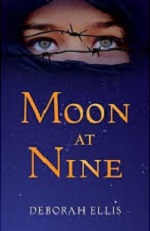
Fifteen-year-old Farrin comes from an affluent family with many privileges and secret support for the Shah of Iran to regain power, which requires her to keep a low profile and separates her from classmates. One day Farrin meets Sadira, a new girl at school, and they become good friends and inseparable immediately sharing tastes for literature and music. As their friendship evolves into a romantic relationship, however, their lives change as same-sex relationships are forbidden in Iranian society. One day their daring acts at school are caught and reported – they are arrested and their lives are at stake. Farrin and Sadira are separated and their parents are advised to find husbands for both girls. Separation cannot break their inner bonds and Farrin and Sadira make a plan to escape Iran with the hope they can be together somewhere else. However, nothing turns out as they expect. After Farrin escapes to Pakistan she learns Sadira was executed by the Revolutionary Guards. Adapted from a true story, this novel takes readers into intimate lives of same-sex relationships in a country which still enforces traditional and religious beliefs. While many places around the world are promoting gay rights and the legalization of same-sex marriage, there are still many places considering homosexuality an unspoken issue. This is a thought-provoking story inviting readers to ponder the interplay of cultural, moral, and sexual issues in different countries around the globe.
—Ying-Hsuan Lee, Washington State University Pullman
These reviews and resources are submitted by members of the International Reading Association’s Children’s Literature and Special Interest Group (CL/R SIG) and are published weekly on Reading Today Online.